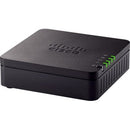Description
The Cisco ATA 191 Multiplatform Analog Telephone Adapter turns traditional telephone, fax, and overhead paging communications devices into IP devices for greater cost-effectiveness. In today’s distributed work environments, businesses need a seamless bridge between legacy analog equipment and modern IP telephony. The ATA 191 delivers that bridge with a compact, reliable design that fits small offices and multi-location deployments alike. By converting analog signals into SIP- or MGCP-based IP traffic, this adapter unlocks the benefits of unified communications, including centralized call handling, scalable conferencing, and easier maintenance. It’s an ideal upgrade path for offices that want to preserve existing handsets, fax machines, and paging speakers while migrating to a flexible, software-driven communications backbone. In essence, the ATA 191 helps you preserve asset investments while embracing the capabilities of modern VoIP systems, from cost savings on long-distance calls to easier disaster recovery across sites.
- Transforms analog devices into IP endpoints: connect standard telephones, fax machines, and paging devices to your IP telephony network to leverage unified communications, centralized management, and scalable routing. This bridge technology enables you to keep legacy hardware in service while you transition to scalable, cloud-ready communications platforms, delivering predictable voice quality and familiar user experiences across locations.
- Two FXS ports for flexible deployment: support for two separate analog devices in a compact, space-saving form factor keeps installation tidy and cost-efficient. Whether you’re provisioning two desk sets, a fax machine in the office, or a paging speaker in a conference area, the ATA 191 provides reliable, synchronized voice paths for every connected device.
- Supports common IP telephony protocols: designed for compatibility with leading SIP-based IP PBXs and multimedia endpoints, enabling seamless integration with your existing UC environment. With SIP signaling and robust media handling, you gain interoperability with popular cloud PBXs, on-premises PBXs, and hybrid deployments, reducing the complexity of multi-vendor networks.
- Fax over IP and media interoperability: features T.38 fax passthrough and optimized media handling to ensure reliable fax transmission in IP networks. This helps preserve your business workflows that rely on faxed documents, while benefiting from faster transmission, lower paper waste, and simplified routing to digital archives.
- Secure, manageable deployment: offers robust security features, remote provisioning, and a web-based management interface for easy configuration across locations and tight control over settings. Centralized monitoring, firmware updates, and access controls help safeguard voice and data while simplifying IT administration in distributed environments.
Technical Details of Cisco 2-Port Analog Telephone Adapter For Multiplatform
- Interfaces: 2 x FXS RJ-11 ports to connect analog telephones, faxes, or paging devices
- Network: Ethernet (RJ-45) interface for IP connectivity to your LAN or WAN
- Protocols: supports SIP-based IP telephony and MGCP for interoperability with diverse IP-PBX platforms
- Power: External power supply required for operation
- Security and management: web-based configuration, remote provisioning options, and secure signaling to help protect voice traffic and simplify administration
How to Install Cisco 2-Port Analog Telephone Adapter For Multiplatform
- Prepare your network: ensure your LAN has a DHCP server or plan for a static IP assignment so the ATA 191 can be reached on the network.
- Connect analog devices: plug your two analog devices (telephone, fax, or paging equipment) into the two FXS RJ-11 ports on the ATA 191.
- Connect to the network: attach a standard Ethernet cable from the ATA 191 to your switch or router to provide IP connectivity to the device.
- Provide power: connect the external power supply and power on the adapter. Allow the device to boot and stabilize before configuration.
- Configure the device: access the web-based management interface using the device’s IP address, log in with the required credentials, and configure SIP/MGCP settings to register with your IP PBX or UC platform. Apply QoS rules if needed and test voice and fax functions to verify call quality.
Frequently asked questions
- Q: What is the Cisco 2-Port Analog Telephone Adapter For Multiplatform used for? A: It acts as a bridge between legacy analog devices (phones, fax machines, paging equipment) and modern IP telephony networks, enabling these devices to operate on SIP/MGCP-based systems while preserving existing hardware investments.
- Q: How many devices can I connect? A: The ATA 191 provides two FXS ports, allowing two separate analog devices to be connected and managed over the IP network.
- Q: Does it support fax over IP? A: Yes, it supports T.38 fax passthrough and optimized media handling to ensure reliable fax transmissions over IP networks.
- Q: What protocols are supported? A: The device is designed to work with SIP-based IP telephony and MGCP for interoperability with various IP-PBX and UC platforms.
- Q: How do I manage and configure the ATA 191? A: It offers a web-based management interface for configuration, monitoring, and firmware updates, with options for remote provisioning to simplify deployment across multiple sites.
- Q: Is this suitable for small businesses? A: Absolutely. The ATA 191 is ideal for SMBs seeking a cost-effective path to IP telephony while preserving their existing analog devices and minimizing disruption.
Customer reviews
Showing - Of Reviews


